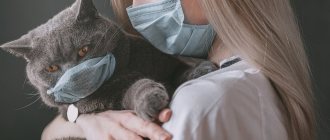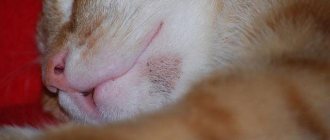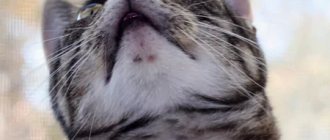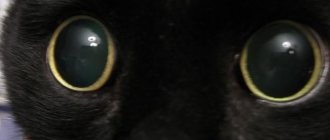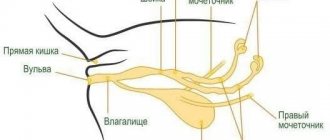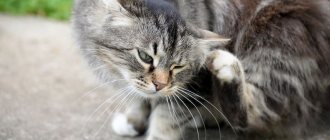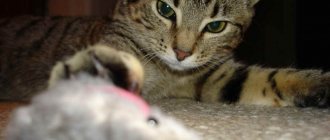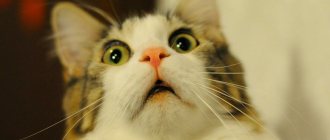List and description of possible causes
It’s rare that owners bring their cat to the veterinarian complaining that it has black specks in its fur. Usually they complain of severe itching and non-healing wounds after severe scratching. If these and other symptoms are present, the following diseases should be excluded:
- Demodecosis. Contrary to the erroneous opinion of some veterinarians, this disease still affects cats, although much less frequently than dogs. Demodex (Demodex cati) is considered a habitual inhabitant of the skin and normally does not cause any pathological manifestations. His activity is always provoked by something. Usually these are recent diseases of the internal organs, the postoperative period, prolonged use of antibiotics or severe hormonal fluctuations. All this manifests itself in the appearance of black grains in the cat’s fur, which are not accompanied by itching. It is important! But demodicosis causes the appearance of large bald spots (in severe cases, even partial baldness), in place of which small black dots appear. There is also the concept of juvenile demodicosis, which occurs in kittens aged 2-6 months. It usually affects the chin and flexor limbs. In most cases, it goes away on its own without the use of any medications. It is noted that demodicosis occurs more often in decorative breeds (Scots, British, Sphynx, Siamese).
- Flea dermatitis. Another reason why a cat may have black spots under its fur. A distinctive feature is that the parasites themselves may not be on the animal, since one bite is enough to provoke an allergic reaction to the flea’s saliva. The pet begins to behave restlessly, scratching its ears or chin (most often).
- Food allergies. A common phenomenon among decorative breeds. The slightest disturbance in the diet can provoke a severe allergic reaction, which manifests itself in the appearance of black grains in the fur, flaking, redness and hair loss (in some cases in clumps). The allergen is determined by exclusion, but most often the owners have to solve the problem for life with the help of drugs against itching and inflammation.
- Fleas. A real nightmare for cats of all ages. Even if you don't see them on your pet, it doesn't mean that fleas aren't biting him. You can get infected from other animals (dogs) or through objects brought from the street (even the soles of your shoes can have parasites). There are many cases when fleas were brought home along with the grass that cats love to eat in the spring and summer. At first, you may notice that your pet begins to itch more than usual (most attention is paid to the face). Over time, you may notice the appearance of black grains of sand under the fur, which fall off the animal after each stroking or combing. Large bald patches begin to appear due to scratching. In these places, brown-black crusts form on the skin due to claw wounds. The most correct solution would be to immediately treat all animals that have access to each other with anti-parasite drugs. Drops on the withers of Stronghold and Frontline are excellent against fleas and ticks. Process 2 times a month. Much attention is paid to the disinfection of housing, which is carried out using Parastop.
- Bacterial damage. A common occurrence in animals predisposed to allergies. Constant itching leads to deep calculations through which infection enters. Wounds can fester and take a long time to heal. Using cytology, the pathogen is determined and effective anti-inflammatory drugs are selected. In severe cases, antibiotic therapy is used.
- Dermatophytosis. A fungal infection that affects the cat's fur and skin. Small black grains and redness can be found at the site of the lesion. As the process progresses, the affected area transforms into a weeping wound the size of an egg. Severe itching leads to deep scratching and the process spreading to other parts of the body. Most often, pets who have free access to the street and, accordingly, to stray animals suffer. To confirm the diagnosis, a deep pluck is taken from the lesion for microscopic examination. This area can also be illuminated under a Wood's lamp, which will show a bright green glow if there are fungal spores in the fur. Treatment is long, with the use of antifungal drugs in the form of tablets, ointments and shampoos. To avoid relapse, all places with which the infected animal comes into contact are thoroughly washed with water and bleach and chlorhexidine.
Treatment
After the diagnosis, appropriate treatment is prescribed, which can be carried out not only in a veterinary clinic, but also at home. Treatment options include:
- Local processing . This includes the use of tar soap, specialized shampoo, including antiseptic solutions or bandages soaked in calendula tincture.
- Use of medications . They are prescribed in a more advanced form. It is also recommended to use a vitamin complex individually selected for each pet for one month.
- Injections that are selected only by a veterinarian.
- Adjustment of daily diet . During the treatment period, the animal is given low-fat food.
Cucumber lotion has an excellent effect on the skin and helps dry out acne . As a result, the black grains dry out and then fall off on their own.
If the cat owner decides to treat it at home on his own, then the following points should be taken into account:
- It is recommended to remove black grains from wool carefully. In this case, you should not use a metal brush, as it can further damage the surface of the skin.
- Do not apply drying agents to blackheads too much, otherwise the skin may become very dry.
- You should carefully lubricate the acne with iodine, brilliant green or alcohol products. This is explained by the fact that an excessive amount of them can activate the sebaceous glands, which will ultimately lead to a worsening of the condition.
- The ointment should not be applied in a too thick layer, otherwise the skin will not breathe, which can lead to resumption of dermatitis.
Treatment is stopped in the following cases:
- If severe irritation occurs. In this situation, the treatment course is suspended until the inflammatory process passes.
- The rashes have increased. This means that the chosen treatment method is ineffective.
- The skin condition has improved and the blackheads have disappeared.
If you do not force the process of blackheads to rash, then the unpleasant symptom can be eliminated by using cosmetics for 7 days. If after one week of treatment the results are negative and the number of acne has increased, then it is better to consult a veterinarian.
To treat blackheads, many owners use folk recipes:
- Rashes are wiped with a decoction of yarrow.
- The affected skin is lubricated with celandine. Can be used as lotions.
- The points are smeared with pumpkin three times a day.
- To treat the affected areas from points, you can use a herbal mixture, which consists of chamomile flowers, calendula, and 2 tablets of crushed furatsilin.
Chlorophyllipt, which is applied pointwise, without rubbing into the skin, has a good therapeutic effect on points. You can add sulfur ointment on top.
Flea - appearance, structure, symptoms
Fleas are found everywhere. This is a fairly large order of insects, which includes subspecies that feed on cat, dog, rat and even human blood. They differ from each other in size, color of the chitinous cover and some features of the body structure.
What does a cat flea look like?
The cat flea is one of the most common and small species among the flea order. The size of an adult insect rarely exceeds 3 mm. For comparison, fleas that feed on human blood have body sizes of up to 5 mm, and moose fleas often reach a length of 12 cm! They move quite quickly on the animal’s body, as they are perfectly adapted for movement in thick fur. They have a body that is flattened laterally, allowing them to maneuver between hairs, and long hind legs, with the help of which fleas are able to make jumps up to half a meter long.
The color of a cat flea can vary from light red to dark brown. Sometimes there are almost black insects that are practically invisible in the fur of an animal with a dark color. Upon closer examination, one can discern light stripes on the abdomen that form at the joints of the abdomen. They become most noticeable when the insect is saturated, when its body increases in size.
What does a flea look like on a cat's body? Outwardly, they look like large grains of dirt stuck in the fur, and only at the moment of their movement it becomes clear that these are insects. A lot of deception is facilitated by flea excrement remaining on the skin of the animal, which is sometimes mistaken for insect eggs.
Flea larvae are not at all similar to adult insects. Outwardly, they look like legless and eyeless dark-colored worms with sparse bristles on the segments of their body. They are very small, no more than 6 mm in length and 1-2 mm in thickness. Unlike adult fleas, larvae do not feed on blood and live outside the animal’s body, in the folds of upholstery of upholstered furniture, carpet pile, and cracks in ceilings.
Flea eggs are small, white, about 0.5 mm long. Females lay them on the floor of the room, where they further develop to the larval stage. Flea eggs look like grains of semolina stuck to your finger:
Interesting fact! Fleas do not live on animals permanently. They only feed on their blood, but live on the floor of the room, in all sorts of cracks and in the upholstery of furniture.
Body structure
If you look at a flea from a close distance, you can see that its entire body is covered with numerous bristles and spines. They help the insect stay on the animal's body. The bristles are located over the entire surface of the body, on the limbs, back, and head. At the ends of the legs, 2 claws are also clearly visible; with their help, the flea moves in the thick undercoat. The hind legs are well developed and consist of 5 segments. The forelimbs are somewhat shorter, they do not participate in jumping and are mainly adapted for moving along the animal’s fur.
Female fleas are usually somewhat larger than males due to their voluminous abdomen, where they carry their eggs for the time being. In the back of the body in both sexes there is a peculiar tactile organ equipped with sensitive hairs.
Symptoms of fleas
- on the back;
- near the ears;
- in the armpit;
- on the skin in the chest and cervical area of the body.
Cats can seriously damage their skin when trying to get rid of insects. Microbes get into the wounds, which in some cases leads to inflammation of the skin and the development of all kinds of dermatitis.
If you suspect that there are fleas in the house, first check the animal's skin. As a rule, insect waste products can be found on it - black lumps of digested blood. When rubbed between your fingers, they break up into small particles. There are usually quite a lot of such traces left in the thick undercoat. In shorter and less dense hair there are fewer of them, since they are combed by the animal onto the floor, where they become food for flea larvae.
Interesting fact! After saturation, fleas jump off the animal and hide in floor cracks or other hard-to-reach places. The next “feeding” occurs no earlier than in a day.
Symptoms
If the owner of a cat notices black grains on her body or on her chin, then it is important to pay attention to other symptoms of the disease:
- Baldness.
- Swelling on the body.
- Redness.
- Small pimples that subsequently increase in size.
It is also necessary to monitor the cat's behavior. The appearance of blackheads can also be accompanied by itching, which constantly itches and brings discomfort and anxiety to the animal. However, an accurate diagnosis should only be made after examination by an experienced veterinarian.
ATTENTION! Based on the diagnostic results, the exact cause of acne formation is revealed.
Causes of fleas
- while walking in contact with an infected animal;
- through household items that have insect eggs and larvae on their surface;
- when adult insects are brought into the house on clothes or their larvae with dirt on shoes;
- from neighboring apartments where there are infected animals.
Do cat fleas bite people? A hungry flea attacks anyone who is nearby. There are no special restrictions in her diet, although she still prefers the blood of animals, and of a certain species. There is evidence that fleas attack people in the absence of their pets. Single bites can also be observed when the apartment is heavily infested with insects.
Fleas from cats are not transmitted to humans in the literal sense of the word. Insects only feed on animals and, accordingly, will not live on humans. However, they can migrate from place to place by jumping onto a person's clothing. This can happen if he walks near their habitat or pets an outdoor cat. Fleas can also move into the folds of clothing if a person picks up care items for an animal infested with insects.
Advice! To protect yourself from flea attacks, you need to carefully monitor the sanitary situation in your apartment - periodically wash the floor, wipe off dust, and wash dirty linen. It is in dust and piles of garbage that insects live and their larvae develop.
Causes and provoking factors
The cause of the problem may be the individual characteristics of the body. At the same time, the owner needs to properly care for the pet, which will reduce the number of black spots. An additional factor in the occurrence of acne in the chin area is that this area has the least amount of hair. This makes it easier for bacteria to get into the pores.
Additional factors:
- poor nutrition;
- hormonal disorders;
- decreased immunity;
- liver diseases;
- pathologies of the sebaceous glands.
When the sebaceous gland is blocked, the excretory duct may become inflamed, which causes pain.
The problem can also occur on the hips, elbows and eyelids. Inflamed sebaceous glands can cause discomfort to the animal, causing pain. The skin in the acne area becomes red and sometimes swells slightly. Chronic intoxication, which occurs as a result of infection of the body with parasites, can provoke the appearance of black spots. At the same time, the waste products of helminths contribute to disruption of the functioning of various systems.
Attention! If a cat has acne, it is necessary to check the condition of the paraanal glands, which are located next to the anus. If they are inflamed, you should definitely consult a doctor. Otherwise, acne will appear again and again.
Why acne occurs in animals - video
Fighting methods
Animal processing
- shampoos
- sprays
- drops
- collars
- pills.
Anti-flea shampoos that contain an insecticide have proven themselves to be excellent. With their help, you can get rid of insects on an animal in one go. They are relatively safe for cats and last quite a long time after treatment. However, shampoos are not always convenient to use, especially if your pet is afraid of water. In this case, you can use flea spray.
Insecticidal preparations in the form of a spray are applied to the surface of the cat's skin, and certain protective measures must be taken to protect both the animal and the person carrying out the treatment. The face is covered with a gauze mask, and gloves are put on the hands. It is best to wear a special collar on your pet, designed to prevent the animal from licking the drug from its fur. You also need to cover the cat's eyes, nose and mouth.
Flea drops are applied to the animal's withers. This is perhaps one of the easiest to use products and is most popular among cat owners. It effectively rids the animal of fleas and at the same time is practically safe for the animal, since the toxic substance is applied to an area of the body inaccessible to the cat’s tongue.
Collars serve more as a preventative measure of protection, repelling insects from the animal while it walks around the yard. They are valid for a limited time and must be changed periodically.
The tablets are intended for internal use. They are given to the cat with food or simply placed on the root of the tongue and, stroking the throat, force it to swallow. As a rule, tablets can be used from 3 months of age, however, the condition of the animal must be taken into account and the dosage must be strictly observed so as not to harm its health.
Vaccination is a relatively new way to rid pets of fleas. It is quite effective and lasts for a long time after injection. However, this method cannot be used on pregnant or lactating cats, as the active substance may affect the growth and development of kittens.
Advice! When choosing a flea drop, you need to carefully study its composition and make sure that it does not contain pyrmethrin, since this insecticide is contraindicated for use on cats.
Treatment of a young animal
How to remove fleas from a kitten? The peculiarity of processing a young animal is that there is always a danger of poisoning it with an insecticidal preparation. Small kittens under the age of two months are breastfed by their mother and any external product applied to their fur will be immediately licked off by her and then passed into the body of the cubs with milk. Therefore, mechanical processing methods are mainly used:
- combing the fur with a fine comb;
- catching insects by hand;
- bathing with herbal decoctions.
There are also special shampoos for younger kittens, but they can be used on babies who have already been weaned from their mother.
From 2 months, provided that the kittens are separated from their mother, the following drugs are used:
- shampoos for kittens;
- flea powder;
- spray.
Shampoos are diluted in accordance with the instructions and applied to the pet’s coat. After a certain time, it is washed off, and dead insects are combed out with a comb. The powder is rubbed into the kitten's skin using your fingers, and care must be taken to ensure that the kitten does not lick the product from the surface of the fur. The spray is first applied to the palms and then distributed over the scalp. When processing, you need to exercise some caution and not bring your hands with the drug to your face.
Starting from 3 months of age, when treating kittens, you can use almost all drugs intended for adult animals.
Apartment pest control
- aerosols;
- powder preparations;
- means in the form of solutions.
Aerosols give very fast and effective results. It is enough to treat the room with them once and you can forget about fleas for a long time. However, this type of insecticide has the following disadvantages:
Powders act for a longer time, however, you have to wait longer for the results from them. Disinsection with their help will require long-term wet cleaning to wash away traces of the insecticide from surfaces. Powder preparations are scattered or sprayed indoors, trying to pay special attention to possible insect habitats:
- cracks in the floor;
- corners of rooms;
- the space behind the baseboards;
- floor surfaces under cabinets, beds, sofas.
Liquid products are diluted in accordance with the instructions and applied to places where insects accumulate using a sprayer. You can also simply wash the floor in your apartment with them. When processing, the following personal safety measures must be observed:
- put rubber gloves on your hands;
- cover your face with a protective mask;
- do not consume food or drinks during disinsection;
- remove food and personal items.
Treatment with liquid products gives a good long-term effect, but it is quite labor-intensive and will require a significant investment of time.
- pseudotuberculosis is an acute infectious disease that, despite the name, has nothing to do with pulmonary tuberculosis;
- tularemia is a bacterial infection that affects the lymph nodes;
- brucellosis is an infection that affects multiple organs and systems of the human body;
- Dipylidiasis - infection with tapeworms.
In addition, it can cause allergic dermatitis; the itching at the bite sites is quite strong and lasts for several days, during which a person is able to scratch the bite site until it bleeds, which, in turn, can lead to infection directly into the wound.
>How do insects get into an apartment?
Fleas are unpretentious in everyday life; they love humidity, dampness, and dark, dusty places in the house. They feed on the blood of humans and animals.
Preventing cat acne
For preventive purposes, in order to prevent black spots from appearing in a cat’s fur, it is advisable to feed the animal from a ceramic, glass or iron bowl. It is better to refuse plastic utensils. It is also worth making sure that the cat always has clean water. It needs to be changed at least once a day.
If your cat is overweight, reconsider his diet. Food should be enriched with microelements and vitamins. Take care of your pet and then black spots in the fur will not bother you or him.
Fleas in cats are quite common. They are found in domestic animals as often as worms. It is impossible to protect your pet from infection 100%. Even if the cat does not have an outdoor run, there is always the possibility of parasite larvae being carried from the street onto shoes or an adult insect entering through the threshold of the front door or ceiling cracks.
One flea will not drink much blood and traces of its presence are almost impossible to detect, but it is capable of leaving numerous offspring, which over time will cause a lot of trouble not only for the animal, but also for its owner.
Effective means
Collars
But you need to remember that the effect of the collar is limited in time, and it must be changed approximately every 3-4 months.
Flea shampoos
An effective flea treatment can be purchased at a veterinary pharmacy. Before use, you should carefully read the instructions, since the concentration of toxic substances in shampoos may differ from each other, so it is important to follow the recommendations on the volume that must be used to treat animal hair.
Flea drops
Insecticides
It is better to purchase toxic flea products for treating your garden plot, basement and premises from the sanitary and epidemiological service. You can also order the treatment of a room or yard if for some reason you cannot do it yourself.
The product must be dissolved in water according to the instructions and thoroughly sprayed on the yard, garden plot or basement. Since poisons are often very toxic, take care to follow safety precautions: wear a respirator and gloves.
Sometimes pet owners are perplexed - they seem to have treated their pet’s fur, but after a while the animal begins to itch and bite fleas again. How so? The fact is that adult fleas live on animals, and they lay their eggs not only in the animal’s fur, but throughout the house:
- in crevices;
- behind the baseboard;
- in the pet's bedding;
- in carpets;
- in places where dust accumulates, etc.
The pests are very small, the length of an adult individual barely reaches three millimeters. Flea eggs are even smaller. They have a round shape and white color. Detecting flea eggs, photos of which can be seen in the article, is extremely difficult. But you need to know where the flea can lay them. Then the problem of how to destroy flea eggs is much easier to solve.
Prevention
As a preventative measure against the appearance of black spots in wool, it is not recommended to use disposable or plastic dishes, which create the necessary conditions for the development of bacteria. It is also important to keep your cat's bowl clean. The water needs to be changed at least once a day.
It is necessary to carefully approach the choice of solid food and filler. They may contain chemicals that trigger an allergic reaction. It is necessary to support the cat’s immunity by purchasing a monthly vitamin complex for it.
ATTENTION! It is important to be attentive to the health of cats and conduct a thorough visual inspection. The appearance of black dots does not depend on the breed of the animal, age or gender. However, it has been noted that neutered and neutered cats develop acne much more often.
It is not recommended to choose independent treatment methods. It is important not to confuse this symptom with similar diseases. It is advisable to entrust this to an experienced veterinarian, who, based on the causes of acne formation, will help determine the correct treatment prescribed based on the individual characteristics of the animal.
White grains (microscopic balls)
White specks on cats' fur can only be noticed upon careful inspection.
One of the strange manifestations of cat malaise is white grains or microscopic balls that fall off the animal’s fur. They are not noticed immediately. At first, they only evoke puzzled glances from the owner and a silent question in his eyes. Where do the mysterious grains come from and what are they?
White grains are nothing more than flea eggs that have not yet hatched. They can get on the animal's skin and, accordingly, on the fur.
What to do and how to detect
If you notice a change in your pet's behavior, carefully examine him to see if he is bothered by fleas.
First of all, you shouldn't panic. In order not to bring the situation to critical limits, it is necessary to monitor the cat more often. This advice may seem very uninteresting and philistine, but this is the only way to notice changes in the health of your pet.
It is necessary to inspect your pet and the places where he recently sat more often. Flea eggs in the form of white grains will be especially noticeable on dark surfaces.
Having discovered uninvited guests, it is important to begin eliminating them as quickly as possible.
What are blackheads in cats and why are they dangerous?
Blackheads (acne) are clogged sebaceous glands. The characteristic dark head occurs when sebum oxidizes. The appearance of such symptoms in an animal may indicate disturbances in the functioning of the body, the presence of parasites. Such a problem cannot be ignored.
Black spots can trigger the occurrence of furunculosis, which is characterized by a purulent process occurring in the inflamed sebaceous gland. This condition is dangerous for the pet’s health and can contribute to the spread of infection. Outdoor animals are most susceptible to acne, but comedones can also occur in indoor cats.
Blackheads in cats are caused by blocked sebaceous glands.
Malfunctions of the sebaceous glands also appear in completely healthy pets. If a cat likes to play outside, a small amount of dirt gets into the mouth and, mixing with sebum, clogs the duct. Most often, comedones are localized on the chin.
When acne occurs, the sebaceous gland becomes inflamed and expands. If the pore is not cleaned in time, bacteria will begin to multiply, which will cause the appearance of pus.
Getting rid of the source of white grains
Bathe your cat only with special shampoos.
- Next, you need to treat the cat with flea drops, which are applied to the withers.
Flea drops for cats are very effective.
- The next step should be a flea collar.
Thanks to special impregnation, the collar repels fleas.
Many limit themselves to drops and ignore collars. Meanwhile, they represent a very powerful defense option. A classic flea collar is impregnated with a special substance that repels fleas. The action continues for 6 months.
Grains, i.e. Flea eggs appear after adult fleas have settled on the body; they lay their offspring.
Consolidate the result
You should pay attention not only to your pet’s hygiene, but also to the cleanliness of its bed or house.
After treating the cat, you should take care of the living space. There are probably eggs left in the apartment that have fallen from the cat’s fur. They can lie unnoticed for a long time until adults hatch from them.
All carpets, mattresses, soft furnishings and bedding should be thoroughly washed and vacuumed. This point should not be missed, otherwise all the cat’s treatment will be in vain.
In addition to the actions taken, a visit to the doctor would be useful. He will examine the animal's body and may find painful scratches on the skin from flea bites. You can do this yourself. But the specialist will give all the necessary recommendations.
Preventive measures
It is important to take action at the slightest suspicion of fleas in a cat.
And of course, it is necessary to have your cat examined at least several times a month. The fur needs to be spread apart so that the skin is visible. A healthy purr is always clean.
How to rid a cat of parasites
Only a specialist can prescribe the right drug that will help and not harm your pet. In case of infection with any parasites, no traditional methods will help.
There are several types of antiparasitic drugs:
- drops;
- injections;
- sprays;
- suspensions;
- pills;
- shampoos.
Drops against external parasites and suspensions with tablets against internal parasites are rightfully recognized as the most effective. Sometimes veterinarians use injections, but this is not common.
Tablets are recognized as the most effective dosage form for fighting worms
The best drugs for worms are:
- Prazicide - suspension for kittens against all types of intestinal worms;
- Praziquantel - tablets against intestinal trematodes and cestodes for all ages;
- Kanikquantel - the active substance in tablets kills all types of intestinal worms and is used from 3 weeks of age;
- Milbemax is the only drug that, in addition to intestinal worms, also destroys heartworms, lungworms and liverworms.
When treating complications of severe parasitic infestations, corticosteroids and antibiotics can be used, but only as prescribed by a veterinarian.
The best drugs for external parasites:
- Beaphar Spot-on - drops used against all external parasites from 12 weeks of age;
- In-Up Complex drops are especially effective against lice eaters, but are also used against other parasites;
- Frontline Merial Combo - drops that destroy parasites at all stages of development: egg, larva and adult;
- RolfСlub 3D - kill parasites and provide protection against mosquitoes and other bloodsuckers;
- Bayer Advantage - helps only against fleas and ticks, but at the same time has a useful property - it destroys their eggs and larvae in all places where the cat likes to lie.
Drops, tablets and suspensions are not only effective, but also easy to use
When treating cestodes, fairly toxic substances are used (toxicity classes 3 and 4), so in case of overdose, side effects may develop: diarrhea, vomiting, and apathetic state.
Photo gallery: drugs for ecto- and endoparasites for cats
Beafar - drops against fleas and ticks for cats, acting quickly and effectively
In-Up Complex is considered to be a reliable protection of animals from endoparasites and ectoparasites at all stages of development
Milbemax tablets for cats are used if a pet is infected with intestinal parasites. Prazicide is a suspension for cats, which is a non-hazardous type of medicine, but before giving it to your pet, you need to consult a veterinarian. Kanikquantel Plus has a wide spectrum of anthelmintic action and is harmful to trematodes. , cestodes and nematodes Advantage for cats is used as an insecticidal agent to combat fleas, lice and other ectoparasites
When treating your cat for parasites, keep the following important points in mind:
- Before using any drug, you should consult with a veterinarian - your cat may have an allergy or intolerance to the components of the product.
- In addition to treating the cat itself, it is necessary to treat the room in which it lives.
- Both cats and premises are treated twice with an interval of 11–14 days to destroy the larvae that have hatched from the eggs.
conclusions
A responsible owner always takes a short course of veterinary lectures without attending classes. Knowledge comes with experience caring for a pet. This is good, because an owner savvy with skills and theory will always be able to help a defenseless animal in a timely manner.
Unfortunately, in the early stages, some dangerous infections occur without obvious symptoms. Only with constant attention to the health and behavior of your pet can you recognize the presence of fleas, worms or worms in your pet.
Treatment:
- treating the affected areas with a weak solution of Citeal (with the permission of the veterinarian);
- applying Butox 50, Amitraz, Advocate or Stronghold;
- special formulations are recommended for the destruction of subcutaneous mites: Acaromectin, Cydem, Neostomazan, Ivermec;
- after removing crusts and partially cleansing problem areas, it is not solutions that are required, but preparations of a thicker consistency: ointments, liniments, gels. Effective products: Amidel-gel, Demos, Aversectin ointment.
Worms
Kinds:
Treatment:
Effective drugs for helminthiasis in cats:
- Alben S (tablets).
- Prazicide (suspension).
- Dironet (suspension).
- Drontal (tablets).
- Pyrantel (suspension).
The essence of the problem
The most common place where cat acne appears is the chin. Dark dots are least likely to be seen on the tail. Fleas or other parasites leave their waste products anywhere on the animal's body. In advanced cases, the spots on the cat’s fur are localized in the following areas :
- folds on the paws;
- inner thighs;
- eyelids;
- nipples;
- jaws.
Dark spots can also be found around the anus. If multiple black rashes appear on your pet's skin, you should see a veterinarian.
What do flea larvae look like?
Flea larvae look like tiny white worms with a translucent body. Even if you look carefully, you cannot see their legs - they simply don’t exist. But the body of the larva is covered with sparse hairs, clearly visible under a magnifying glass or microscope.
The photo, enlarged several times, shows a flea larva:
In her body, the esophagus is clearly visible, filled with digestible food - various organic residues.
The maximum length of flea larvae that can be found in residential premises is 4-5 mm, the usual length is 2-3 mm. They can easily be confused with fly larvae that live in similar places, but the maggot is more mobile and does not have such transparent body coverings.
The flea larva has a fairly large head and 13 segments. Evolutionarily, the first three segments served to attach the legs, but gradually the limbs atrophied as unnecessary. Flea larvae have well-developed jaws of the scraping-gnawing type, allowing them to feed on fairly rough food.
The photo below shows flea eggs and larvae:
The smallest flea larvae, just emerging from the egg, have a small egg tooth on the crown of their head - a hard outgrowth that helps them break through the egg shell and emerge into the world. At the first molt, the tooth falls off along with the chitinous shell of the body.
In the photo there are large numbers of flea larvae in a rodent cage:
On a note
The development of the larva continues, depending on the availability of food and temperature conditions, from 9 days to several months.
Under optimal conditions - a temperature of about 23°C and an air humidity of 60%, the larvae develop in approximately three weeks. During this time, they molt three times, constantly grow and feed. At the last stage, the larva envelops itself in a thin silk cocoon and turns into a pupa.
At too high temperatures, flea larvae dry out - at low humidity this occurs already at 34-36°C. At high air humidity (up to 90%), growing juveniles experience this temperature quite normally.
Flea larvae can starve for quite a long time - up to 3-4 weeks. At the same time, they do not develop, do not grow, but also do not fall into suspended animation. The larvae have developed the so-called negative phototaxis - wherever they find themselves, they try to get into the least illuminated place. Although the eyes of flea larvae are practically undeveloped, they sense the presence of light well and try to hide from the illuminated place.
Where to look for flea larvae in an apartment or house?
Flea larvae usually stay where they have direct access to food and can be found in comfortable climatic conditions - in garbage, secluded warm places, in animal cages - in the toilet and under beds. In nature - in the nests and burrows of mammals and birds.
In apartments and houses, flea larvae should be looked for primarily in places where cats, dogs and other pets live and are kept, in heaps of garbage in pantries and closets, among stocks of old grocery products.
In garden plots, chicken coops and animal keeping areas, flea larvae live directly in the litter and dried droppings. It is under the layer of garbage and droppings in the same chicken coop that flea larvae sometimes swarm literally in the thousands.
However, you can also find flea larvae in completely unexpected places - in vases with flowers, under trash cans, in a box in which vegetables are stored. It is important to understand that they do not start here on their own, and you should look for them only when adult fleas were found in the apartment.
The photo below shows a flea larva under a microscope - you can easily correlate its size with the thickness of a cat's hair:
Means and methods for destroying flea larvae
Flea larvae should be destroyed indoors using the same means that are used against adult fleas:
- these can be as concentrates for dilution such as Executioner, Cucarachi or Tetrix, Raptor or Combat aerosols;
- as well as microencapsulated products such as Dana or Get (the latter has almost no odor);
- and even folk remedies - turpentine, kerosene, vinegar.
Traditional substances such as Dichlorvos or Karbofos are also effective against flea larvae, but in terms of safety and ease of use they are much inferior to modern drugs.
Dusts are also effective against flea larvae, but are practically useless against adult fleas. However, using powdered insecticides is somewhat more difficult, since they need to be scattered in places where the larvae are constantly located, which is sometimes problematic, and sometimes, when the larvae are found behind baseboards or under the floor, it is completely impossible.
In this case, it is very important that the dust itself is certainly near the larvae, since it only works when the pests eat it along with other food. Therefore, it turns out to be generally more difficult to deal with larvae than with adult fleas - even with aerosols, when fighting them, you need to treat places where it is very difficult to get close and where adult fleas themselves are not found.
Preventive measures
A few more simple measures:
More useful information on how to recognize the presence of worms in your beloved pet and how to deal with them can be heard by watching the following video:
Fleas, like many other types of insects, undergo a complete transformation in their development. Actually, that’s what they’re called: insects with a full cycle of transformation. This means that the eggs laid by the female flea hatch into larvae that are very different from adult fleas in both their appearance and lifestyle.
The cat is constantly dropping black dots. Treatment and prevention of fleas in cats
The eggs hatch into larvae, which spin cocoons and develop into pupae before developing into adults. Depending on environmental conditions such as temperature, humidity and the presence or absence of hosts, the cycle can take anywhere from several weeks to several months.
Cat flea larvae hatch from eggs that an adult female flea lays on its host, the cat. They do not remain on the body, but fall off when the cat moves. The animal stands up, stretches and shakes itself, and the flea eggs simply fly off into the environment.
Flea eggs look like translucent oval dots about 0.5 mm long. But it is quite difficult to see them, since they quickly dry out after being deposited, become heavier and fall out of the cat’s fur. The best place to look for flea eggs is in your cat's bedding and other places where your cat likes to sleep. If the cat is heavily infected, you can look with a magnifying glass at the base of the tail or on the stomach. If there is flea dirt in your cat's bedding, it likely contains flea eggs. Flea dirt is dark and the eggs in it have a whitish appearance.
Fleas survive by jumping on a host animal, burrowing into its skin and feeding on blood. In most cases they cause only mild itching, but in severe infestations, especially in kittens or older sick cats, they can cause severe anemia or even death of the cat. Fleas are also intermediate hosts of helminths. Some cats are hypersensitive to flea saliva. This causes severe itching and a local or general skin reaction.
A flea infestation can be identified by finding fleas on your cat or by seeing black and white flecks in the cat's fur, similar to grains of salt and pepper. These particles are flea feces (“pepper”) and their eggs (“salt”). Feces are formed from digested blood. If you comb them onto damp paper, they turn reddish-brown.
An adult flea is a small, dark brown insect, about 2.5 millimeters in size, that can be seen with the naked eye. Although fleas do not have wings and cannot fly, they have powerful hind legs that can be used to jump long distances. Fleas move quickly in fur and are difficult to catch.
Look for fleas on the cat's back and in the tail and back of the body. To do this, run a fine-toothed comb through the fur. Sometimes fleas are visible in the groin area, where it is warm and there is less fur. Itching is most severe in these areas.
How to cure acne in a cat?
The owner can carry out the treatment procedures recommended by the veterinarian independently. Antiseptics are used to treat skin and wool - salicylic alcohol or Chlorhexidine. After the procedure, thorough drying is carried out. It is imperative to include vitamin supplements in the diet and transfer the animal to high-quality food with a minimum of fat.
To dry the skin and normalize the functioning of the sebaceous glands, use tar soap or shampoo or cucumber lotion. The dirt dries up and disappears after 2-3 days. For bloody, purulent crusts, external antibacterial drugs are prescribed: Mupirocin, Bactroban. Oral antibiotics are given if a secondary infection develops. If the inflammatory reaction is severe, then corticosteroids are prescribed, for example, Prednisolone. For rashes on the face, it is recommended to use Clotrimazole or Chlorophyllipt. They are not rubbed in, but applied pointwise to the skin. Be sure to cover the top with sulfur ointment. Recommendations for the owner before starting treatment:
- If the pet has long hair, then the grains are combed out. To do this, use a soft brush, since a metal comb can damage the skin.
- Do not overdo it with drying agents, as they have a direct effect on the skin.
- It is better not to use iodine or brilliant green to treat damaged skin, as they enhance the work of the sebaceous glands. This makes the problem worse.
To combat acne, the use of traditional medicine is common. A decoction of yarrow is used to wipe acne spots on the lips. The affected areas of the skin are treated with celandine. A cut of fresh pumpkin, a mixture of chamomile, calendula and Furacilin are also often used.
Black dots in a cat's fur are a symptom that requires consultation with a veterinarian. If the taken therapeutic measures do not have an effect, then the problem is physiological in nature. Only a doctor can help with this, so don’t put off going to the clinic.

